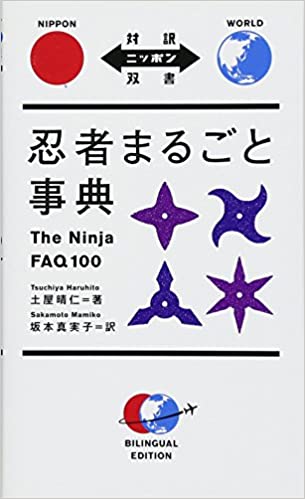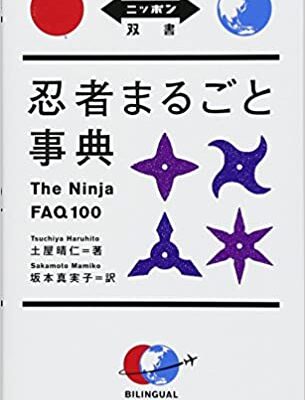土屋晴仁、坂本真実子 著「忍者まるごと事典」 対訳ニッポン双書
京都の土産物店に訪日外国人を案内している時に見つけた本です。対訳ニッポン双書シリーズの本が並べられている中で、すごく気になった本です。思わず買ってしまいました。本書は左のページに日本語、右のページに英語で同じ内容が書かれていますので、対訳を調べるのに便利です。
内容自体は、今まで紹介してきた忍者関連の本をベースにしているので、目新しいことはなかったのですが、全文英訳されていて直ぐに役立ちます。ページ数も150ページの新書版サイズですので、通訳ガイドの方が持ち歩くにも、いい大きさです。それでは、実際に使ってみようと思ったエピソードを、いくつか紹介します。
1つ目は、忍者の採用試験について。どこで、誰によって行われたのかは定かではありませんが、本書によると音を立てずに歩く試験が課されたようです。忍者志願者に、くしゃくしゃにした紙をばらまいた部屋を歩かせ、如何に音を立てずに歩くかを試しました。これは難しいと思うと同時に、少しバカバカしくも思えました。
2つ目は、クナイ(苦無)という武器についてです。どのような武器かというと、三角形の楔(くさび)型をして、その三角形の二等辺部分が諸刃の刃になっています。そして柄の先に輪の形になっていることが多い武器です。スコップ代わりに、壁や地面に穴をあけるのに用いたり、あるいは、石垣や壁を登る際に、その隙間に差し込んで、足場として利用したりしました。また、柄の先の円の部分に紐を通して、振り回して武器としても使えたようです。
3つ目は、薬や毒薬についてです。昔から、伊賀や甲賀の里山は、薬草の産地として知られていました。ですので、そこで採れる薬草を使いこなすかの知恵が、古くから蓄積されていたようです。外傷に効く薬や、回虫や下痢、カゼに効く内服薬だけでなく、トリカブトなどの暗殺のための毒薬や、幻覚を起こさせる大麻など、薬と毒薬・劇薬を用いていました。
最後は呪文です。他の書籍でも様様な忍者の唱える呪文が紹介されていますが、インド伝来の軍神で女神の摩利支天の呪文が紹介されています。「隠形(おんぎょう)の印」を印を結びながら、「オン・アニチ・マリシエイ・ソワカ」と呪文を唱えます。詳しいことは、本書をご参照ください。(完)

価格:1,760円
(2021/6/6 17:13時点)
感想(0件)
Haruhito Tsuchiya and Mamiko Sakamoto, “Ninja Marugoto Jiten (Dictionary of the Ninja)”, Bilingual Nippon Sosho (Japanese translation of a bilingual book)
I found this book when I was guiding foreigners visiting Japan to a souvenir store in Kyoto. Among the books in the Bilingual Nippon Sosho series lined up, I was very interested in this book. I bought it without a second thought. This book has the same contents written in Japanese on the left page and in English on the right page, so it is convenient to look up the bilingual translation.
The content itself is based on the ninja-related books I have introduced so far, so there was nothing new in it, but it is translated into English in its entirety, so it is useful right away. It is a new book size book with 150 pages, so it is a good size for interpreter guides to carry around. Now, let me introduce some episodes in which I actually tried to use the book.
The first is about the ninja recruitment test. It is not clear where or by whom, but according to this book, a test to walk without making a sound was imposed. The ninja applicants were asked to walk around a room with crumpled paper scattered around them, and they were tested on how they could walk without making a sound. This seemed difficult and at the same time a bit silly.
The second was a weapon called kunai. It is a triangular wedge-shaped weapon with a double-edged blade on the isosceles of the triangle. The handle is often in the shape of a loop at the end of the weapon. It was used as a shovel to make holes in walls and the ground, or as a foothold when climbing stone walls and walls by inserting it between the gaps. It could also be used as a weapon by threading a string through the circle at the end of the handle and swinging it around.
The third is about medicines and poisons. The satoyama of Iga and Koga were known for medicinal herbs since long ago. Therefore, there seems to have been accumulated wisdom on how to use the medicinal herbs that could be found there from ancient times. They used not only medicines for external wounds and internal medicines for roundworms, diarrhea, and colds, but also medicines and poisonous or deleterious drugs such as aconite and other poisons for assassination and hallucinogenic marijuana.
Finally, there are spells. Other books have introduced a variety of ninja spells, but this book introduces the spells of Marishiten, the goddess of war and goddess of India. The incantation is “On Anichi Marishiei Sowaka” (On Anichi Marishiei Sowaka), while making the sign of Ongyo (Hidden Form). For more details, please refer to this book. (End)
Haruhito Tsuchiya et Mamiko Sakamoto, “Ninja Marugoto Jiten (Dictionnaire des Ninja)”, Bilingue Nippon Sosho (traduction japonaise d’un livre bilingue)
J’ai trouvé ce livre alors que je guidais des étrangers visitant le Japon dans un magasin de souvenirs à Kyoto. Parmi les livres de la série Bilingual Nippon Sosho alignés, ce livre m’a beaucoup intéressé. Je l’ai acheté sans hésiter. Ce livre a le même contenu écrit en japonais sur la page de gauche et en anglais sur la page de droite, il est donc pratique de consulter la traduction bilingue.
Le contenu lui-même est basé sur les livres sur les ninjas que j’ai présentés jusqu’à présent, donc il n’y avait rien de nouveau, mais il est traduit en anglais dans son intégralité, donc il est utile immédiatement. Il s’agit d’un nouveau livre de 150 pages, ce qui en fait un livre de bonne taille à transporter pour les guides interprètes. Maintenant, laissez-moi vous présenter quelques épisodes dans lesquels j’ai réellement essayé d’utiliser le livre.
Le premier concerne le test de recrutement des ninjas. On ne sait pas exactement où ni par qui, mais selon ce livre, un test consistant à marcher sans faire de bruit était imposé. On demandait aux candidats ninjas de marcher dans une pièce avec du papier froissé éparpillé autour d’eux, et on les testait sur leur capacité à marcher sans faire de bruit. Cela semblait difficile et en même temps un peu stupide.
La seconde était une arme appelée kunai. C’est une arme triangulaire en forme de coin avec une lame à double tranchant sur l’isocèle du triangle. Le manche est souvent en forme de boucle à l’extrémité de l’arme. Elle était utilisée comme pelle pour faire des trous dans les murs et le sol, ou comme prise de pied lors de l’escalade de murs de pierre et de murailles en l’insérant entre les interstices. On pouvait également l’utiliser comme arme en enfilant une ficelle dans le cercle situé à l’extrémité du manche et en la faisant balancer.
La troisième concerne les médicaments et les poisons. Les satoyama d’Iga et de Koga étaient connus pour leurs herbes médicinales depuis longtemps. Par conséquent, il semble qu’une sagesse ait été accumulée sur la façon d’utiliser les herbes médicinales que l’on pouvait y trouver depuis les temps anciens. Ils utilisaient non seulement des médicaments pour les blessures externes et des médicaments internes pour les vers ronds, la diarrhée et les rhumes, mais aussi des médicaments et des drogues toxiques ou délétères comme l’aconite et d’autres poisons pour l’assassinat et la marijuana hallucinogène.
Enfin, il y a les sortilèges. D’autres livres ont présenté une variété de sorts ninja, mais ce livre présente les sorts de Marishiten, la déesse de la guerre et déesse de l’Inde. L’incantation est “On Anichi Marishiei Sowaka”, tout en faisant le signe de Ongyo (forme cachée). Pour plus de détails, veuillez vous référer à ce livre. (Fin)
